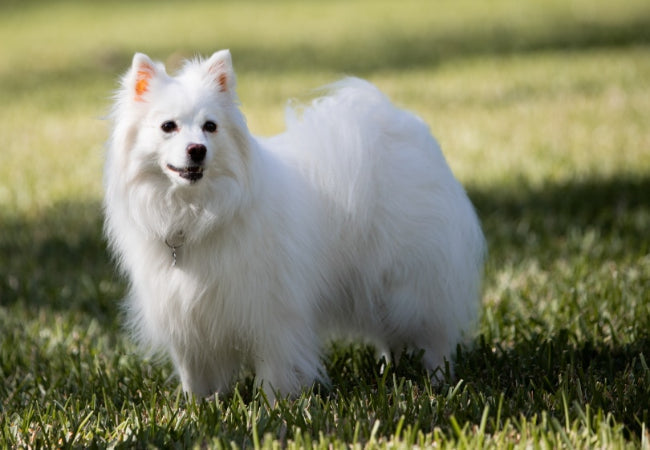American Eskimo Dog Guide: Health, Training & Lifestyle 🐶✨

In this article
American Eskimo Dog Guide: Health, Training & Lifestyle 🐶✨
By Dr. Duncan Houston BVSc
The American Eskimo Dog—aka “Eskie”—is a brilliant, alert, and energetic performer. Bred from German Spitz dogs and perfected in American circuses, this white-coated athlete thrives on attention, training, and companionship. As your veterinarian, here’s my deep dive into their care: health, behavior, grooming, and how to support their spirited lifestyle using Ask A Vet.
📘 Breed Origins & Physical Traits
- Heritage: Descended from the German Spitz and circus performers—not Arctic sled dogs.
- Recognition: UKC 1919, AKC 1995; known historically as "American Spitz" during wartime.
-
Sizes:
- Toy: 9–12″ / 5–10 lb
- Miniature: 12–15″ / 10–20 lb
- Standard: 15–20″ / 25–35 lb
- Coat: Medium-length white double coat—fluffy, thick, and shedding-prone.
- Temperament: Intelligent, friendly, alert—ideal watchdogs. Sociable yet reserved with strangers.
- Lifespan: 13–15 years—longevity supported by good care.
🏡 Ideal Home & Lifestyle
Eskies need engagement, not isolation:
- High energy and mental stimulation—they were circus performers for a reason.
- Best suited to homes with adults or older children—fragile toy sizes and barking may overwhelm younger kids.
- Adaptable from apartment to house if they receive daily exercise (≥ 60 min) and attention.
✂️ Grooming & Coat Care
Their fluffy coat needs commitment:
- Brush at least 3× weekly; daily during seasonal shedding to prevent mats.
- Occasional baths—overbathing dries skin and disrupts coat oils.
- Cry for routine ear cleaning (trim the fur around them), dental brushing ≥ 3× weekly, and nail trims.
Vet Tip: Use the Ask A Vet app to set grooming reminders and upload coat photos to get ahead of skin issues or mats.
🍽️ Nutrition & Feeding Plan
- Use small or large-breed formulas suited to size; serve 2 meals daily.
- Portion control is key—track weight monthly in Ask A Vet to prevent obesity.
- Include supplements: omega‑3 for skin coat, probiotics post-antibiotics or GI upset.
- Prevent bloat by avoiding table scraps and skipping vigorous exercise pre-/post-meal.
🏃 Exercise & Mental Enrichment
Energetic and intelligent—they need both body and brain workouts:
- Daily walks, play sessions, and trick-learning activities.
- Use Woopf interactive toys and puzzle feeders to challenge their clever minds.
- Agility and obedience classes align with their performance heritage.
- Rotate toys and training games regularly to prevent boredom-induced mischief.
Log session durations, new tricks, and behavior changes in Ask A Vet to track progress and detect burnout or stress.
🩺 Health Screening & Common Issues
Eskies are robust, but some conditions deserve attention:
- Hip Dysplasia: Moderate risk—screen early via OFA/X-ray.
- Progressive Retinal Atrophy (PRA – PRCD): Genetic testing is available.
- Dental Disease: Serious early problems—brush ≥ 3× weekly.
- Bloat (GDV): Low risk compared to large breeds, but still avoid excited post-meals.
- Allergies: Skin or food sensitivities—watch for itching, redness, ear wax.
- Patellar Luxation: Toy/minis more prone—monitor for limping or skipped steps.
Vet Schedule: Annual exams with weight, dental, joint, and eye checks; add genetic testing for PRA. Manage all reminders via Ask A Vet.
🎓 Training & Behavior Insights
Smart, eager, and obedient—don’t let that fluffy exterior fool you:
- Early socialization builds confidence and prevents stranger fear.
- Reward-based training with Woopf toy rewards, treats, and praise.
- Keep training sessions playful and short; Eskies love variety.
- Teach impulse control—for example, “Quiet” command prevents over-barking.
Track progress and challenges in Ask A Vet’s behavior journal for tailored support and troubleshooting in-message.
👨👩👧 Family Fit Assessment
✅ Ideal For:
- Active singles or families who can engage daily
- Older children (≥ 6 years) who match their energy
- Homes that appreciate grooming and interactive training
❌ Caution For:
- Busy families, frequent travelers—Eskies can develop separation anxiety
- Homes with toddlers—delicate toy sizes risk rough handling; vocal habits might be problematic
📱 Ask A Vet
- Ask A Vet: Comprehensive tracking—weight, grooming, training, reminders, vet chat
⭐ Real-Life Case Study: “Luna the Eskie Superstar”
Luna, a 4-year standard Eskie, tended to bark excessively when bored. Her owners logged behavior in Ask A Vet, revealing spikes when alone. We introduced:
- Short training sessions before owners left—“Luna’s Trick” cue
- Daily neighborhood walks and agility drills
Within a few weeks, barking reduced by 60%, confidence improved, and the family reported a calmer, more content canine companion.
🧑⚕️ Final Words from Dr Duncan Houston
The American Eskimo Dog is a heartwarming mix of performance, loyalty, and fluff. With early socialization, smart training, proactive health care, and engaging enrichment, they’ll flourish in your family.
Next steps? Log their size and coat growth in Ask A Vet, schedule genetic and health screenings, and help Luna—or your Eskie—achieve superstar status in everyday life.






